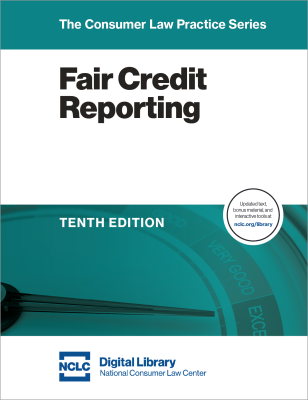(Article Updated Sept. 3, 2025)
About 15 million consumers have medical debt on their credit reports, and it is controversial whether such bills should be included on credit reports because the medical debt is often unplanned, unavoidable, and unaffordable. Study after study finds that medical debts have little to no predictive value as to whether a consumer will repay a debt. In many cases, the debt may not even be owed or the amount may be inaccurate; medical billing is particularly problematic given the complex interface with insurance.
The response to criticism of medical debt on credit reports has been three-fold: rulemaking by the Consumer Financial Protection Bureau (CFPB), state legislation, and voluntary actions by the Big Three credit bureaus (Equifax, Experian, and TransUnion). The credit bureaus are officially known under the Fair Credit Reporting Act (FCRA) as the nationwide consumer reporting agencies (CRAs).
This article brings readers up to date on the latest developments on all three fronts: litigation involving the CFPB rule, new state legislation, and how consumers should respond to the voluntary actions by the big three nationwide consumer reporting agencies.
Credit Reporting Agencies Voluntarily Limit Reporting of Medical Debt
In 2022, nationwide CRAs agreed to three changes to reduce the amount of medical debt in credit reports:
- Refraining from including medical debt in credit reports if the debt is less than one year delinquent;
- Removing paid medical debt from credit reports, so that there would be no indications that these debts were ever in default;
- Omitting any medical debt under $500 on credit reports. Medical debts under $500 will never be reported even if unpaid and even if in collection. This change took effect in the Spring of 2023.
In 2025, the nationwide CRAs also are voluntarily offering free credit reports once a week instead of once a year as required by the FCRA. Consumers should regularly order a free report from each of the nationwide CRAs to ensure that the CRAs are complying with these voluntary policies and with the state limits described below. Importantly, one should obtain a free credit report from the central source and not by opening an account with an individual CRA that might require the applicant to agree to mandatory arbitration of any dispute they have with the CRA.
Obtain the report from the central source in any of these ways:
- Order online at www.annualcreditreport.com/index.action;
- Call 877-322-8228; or
- By mail: go to www.annualcreditreport.com/gettingReports.action, click on “request form” under the mail heading, then print out and complete the annual credit report request form and mail it to Annual Credit Report Request Service, P.O. Box 105281, Atlanta, GA 30348-5281
New Court Ruling on the CFPB Medical Debt Rule
A federal court in the Eastern District of Texas has just vacated the CFPB’s Medical Debt Rule in its entirety. See Cornerstone Credit Union League v. Consumer Fin. Prot. Bureau, 2025 WL 1920148 (E.D. Tex. July 11, 2025).
The CFPB issued the rule in January 2025. See Prohibition on Creditors and Consumer Reporting Agencies Concerning Medical Information (Regulation V), 90 Fed. Reg. 3276 (Jan. 14, 2025). The rule prohibits CRAs from including medical debt information in consumer reports when those reports are provided to creditors for the purpose of making credit determinations. It also forbids creditors from considering medical debt information when making credit decisions.
After the rule was challenged in federal court, the court granted the CFPB’s request, under a new director, to stay the rule’s effective date while the CFPB reevaluated its position on the rule. Soon thereafter the CFPB and the plaintiffs filed a Joint Motion for Consent Judgment in which the parties requested the court, pursuant to their agreement, to enter a final judgment vacating the Medical Debt Rule.
After allowing for the intervention in the case of other parties, represented by NCLC, the court found that the rule exceeded the CFPB’s statutory authority. The court granted the motion to vacate the rule in its entirety. See Cornerstone Credit Union League v. Consumer Fin. Prot. Bureau, 2025 WL 1920148 (E.D. Tex. July 11, 2025). The impact of the court’s decision is to vacate the rule nationwide and prohibit the CFPB from enacting a similar rule in the future. Despite comments in the decision, the ruling has no direct impact on state laws. (See below for a discussion of FCRA preemption of state medical debt reporting statutes.)
Fifteen States Already Limit Medical Debt Reporting
There has been strong recent activity by states to adopt medical debt credit reporting bans. Nine of the fifteen recent state statutes on medical debt reporting go into effect this year or on January 1, 2026. The remaining statutes were effective in either 2023 or 2024.
State statutes that ban medical debt in credit reports contain several different types of prohibitions, which regulate different sets of actors. These include:
- Prohibitions on consumer reporting agencies (CRAs) inserting medical debts in credit reports;
- Prohibitions on providers and debt collectors (called “furnishers”) reporting or furnishing medical debt to CRAs;
- Prohibitions on creditors using medical debts on credit reports in their credit decisions.
All fifteen state medical debt reporting statutes are listed below. This list draws upon a July 11, 2025, Consumer Federation of America blog, Does Your State Allow Medical Bills to Appear on Credit Reports?, by Brad Lipton, Ethan Weiland & Rockaya Ndoye, which also breaks down each state statute using the categories above. See also NCLC’s Fair Credit Reporting § 5.4.5.1.4.
California: Senate Bill 1061 (Cal. Civ. Code §§ 1785.13(a)(7), 1785.20.6, 1785.27, 1786.18(a)(9), 1371.56(C)(1)(A) (West)) enacted September 24, 2024, and effective July 1, 2025, limits the furnishing of medical debt information to CRAs, CRAs reporting medical debt information, or anyone using medical debt information in credit evaluations.
Colorado: House Bill 23-1126 (Colo. Rev. Stat. § 5-18-109) enacted June 5, 2023, and effective August 7, 2023, limits CRAs reporting medical debt information.
Connecticut: Public Act 24-6 (Conn. Gen. Stat., §§ 19a-673b, 20-7i) enacted May 9, 2024, and effective July 1, 2024, limits furnishers from reporting medical debt information.
Delaware: Senate Substitute 1 for Senate Bill 156, enacted July 29, 2025, and effective October 27, 2025, prohibits the furnishing of medical debt information to CRAs and prohibits CRAs from reporting medical debt information.
Illinois: Public Act 103-0648 (815 Ill. Comp. Stat. 505/2EEEE), enacted July 2, 2024, and effective January 1, 2025, limits CRAs reporting medical debt information.
Maine: Me. Rev. Stat. tit. 10, §§ 1308, 1310-H enacted June 2, 2025, and effective June 9, 2025, limits the furnishing of medical debt information to CRAs, and CRAs reporting medical debt information.
Maryland: Senate Bill 614 (Md. Code Ann., Com. Law § 14-1213; Md. Code Ann., Health-Gen. §§ 19-214.2(f), 24-2501, 24-2502) enacted April 22, 2025 and effective October 1, 2025, limits the furnishing of medical debt information to CRAs and CRAs reporting medical debt information, or anyone using medical debt information.
Minnesota: Ch. 114-S.F 4097 (2024) (Minn. Stat. ch. 332C), enacted May 21, 2024, and effective October 1, 2024, contains a limit on the furnishing of medical debt information to CRAs and CRAs reporting medical debt information.
New Jersey: Senate Bill 2806 (N.J. Stat. Ann. § 56:11-58 (West)) enacted July 22, 2024, and effective July 22, 2024, limits the furnishing of medical debt information to CRAs and CRAs reporting medical debt information under $500.
New York: Senate Bill 4097A (N.Y. Gen. Bus. Law § 380-j(f)(1) (McKinney); N.Y. Pub. Health Law, art. 49-A (McKinney)) enacted February 17, 2023, and effective February 17, 2023, limits the furnishing of medical debt information to CRAs and CRAs reporting medical debt information.
Oregon: Senate Bill 605 (Or. Rev. Stat. § 646A.677(11), (12)) enacted on June 10, 2025, and effective January 1, 2026, limits both the furnishing of medical debt information to CRAs and CRAs reporting medical debt information.
Rhode Island: Senate Bill 2709 (6 R.I. Gen. Laws §§ 6-60-1 to 6-60-5) enacted June 24, 2024 and effective July 1, 2025, limits the furnishing of medical debt information to CRAs and CRAs, reporting medical debt information.
Vermont: Vt. Stat. Ann. tit. 9, § 2466d and Vt. Stat. Ann. tit. 18, § 9485(b), were enacted on May 16, 2025, and are effective July 1, 2025, both limit the furnishing of medical debt information to CRAs and CRAs reporting medical debt information.
Virginia: House Bill 1370 (Va. Code Ann. § 59.1-444.4) enacted April 17, 2024, and effective April 17, 2024, limits the furnishing of medical debt information to CRAs.
Washington: Senate Bill 5480 (Wash. Rev. Code §§ 19.16.100, 19.182.040(1)(g), 19.16.250(28)(a)(iii), 70.41.400(2); ch. 70.54) enacted on April 22, 2025, effective July 27, 2025, limits both the furnishing of medical debt information to CRAs and CRAs reporting medical debt information.
Does the FCRA Preempt State Medical Debt Reporting Laws?
Given the increasing number of states prohibiting medical debt on credit reports, one critical issue is whether the FCRA preempts such statutes. The court in the Cornerstone v. CFPB decision discussed above thought so, stating “any state law purporting to prohibit a CRA from furnishing a credit report with coded medical information would be inconsistent with FCRA and therefore preempted.” 2025 WL 1920148, at *12.
However, this sweeping statement is dicta, as the issue of potential preemption of state statutes prohibiting CRAs from including medical debt in credit reports was not before the court. (The court’s relief struck down the CFPB’s rule but did not address any state laws.) And the court’s statement was made without any analysis of any state statute, the existing case law on preemption, or the FCRA’s specific statutory scheme regarding preemption.
As discussed above, state statutes that prohibit medical debts on credit reports regulate the CRAs, the furnishers of the medical debts, or the creditor using the information. Only the third category of state laws was even relevant to the issue before the court in Cornerstone, since the CFPB medical debt rule included a provision that prohibited CRAs from including medical debts on credit reports in states where the creditor is prohibited from considering it.
The court in the Cornerstone decision did not say that state laws prohibiting creditors from considering medical debt were preempted. Instead, the court said that state laws prohibiting CRAs from including medical debt on credit reports were preempted. This issue was not before the court, not briefed, and not necessary for the court’s final judgment. The court also did not have before it—and it did not consider—the preemption of state laws prohibiting furnishers from reporting medical debts to CRAs. Regardless, the preemption remark is dicta, as the court rested its actual holding on its interpretation of the regulatory authority “permissible purpose” provisions of the FCRA, which the CFPB relied upon as the statutory basis for its rule.
Notably, the court did not analyze or even cite any case law in its preemption discussion, including Consumer Data Indus. Ass'n v. Frey, 26 F.4th 1 (1st Cir. 2022), which held that a state law restriction on reporting of medical debt was not preempted, narrowly construing the scope of FCRA preemption with respect to the contents of consumer reports, or Aargon Agency Inc. v. O’Laughlin, 70 F.4th 1224 (9th Cir. 2023) and Galper v. JP Morgan Chase Bank, 802 F.3d 437 (2d Cir. 2015), which did the same with respect to state laws governing furnishers.
The court also did not discuss or parse the actual FCRA statutory provisions regarding preemption. The FCRA has a complicated preemption scheme, providing for at least three different standards. Different sections and even subsections of the FCRA are subject to varying standards of preemption. See NCLC’s Fair Credit Reporting § 10.7.
For these reasons, the dicta in Cornerstone has no legal effect in the fifteen states that have adopted prohibitions against medical debt credit reporting. The status of these states’ laws would need to be contested in a court with jurisdiction, presumably in a court located within each relevant state, and the states would then have the opportunity (and ample grounds) to defend those laws there. As noted, a close reading of the actual final judgment in Cornerstone reveals no order or injunction with respect to state laws—nor could the court have made such a ruling in these circumstances, where the issue was not before it.
NCLC has issued guidance on additional provisions that will maximize the chances of state law provisions standing up to preemption, such as requiring health care providers to include provisions in their contracts with debt collectors prohibiting the collectors from reporting their debts to CRAs. See NCLC’s Prevent Medical Debt from Ruining Credit Reports: Recommendations in the Face of Potential Federal Preemption Threat (May 2025).
Acknowledgments
Thanks for contributions to this article by Brad Lipton of the Roosevelt Institute and NCLC senior attorney, Jennifer Wagner.


